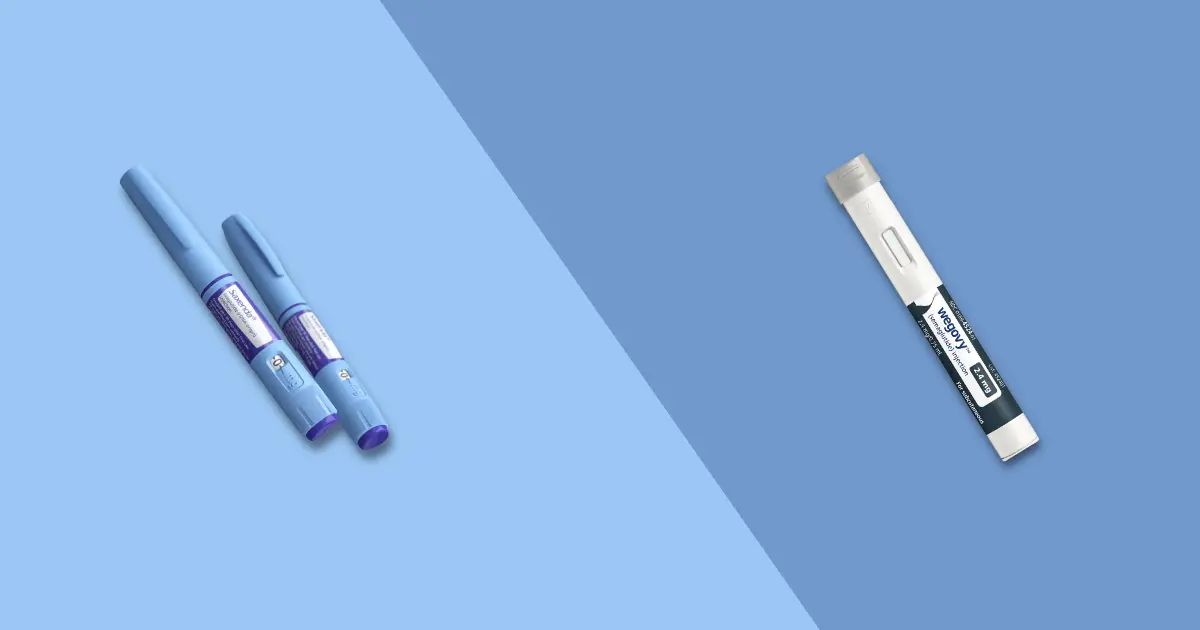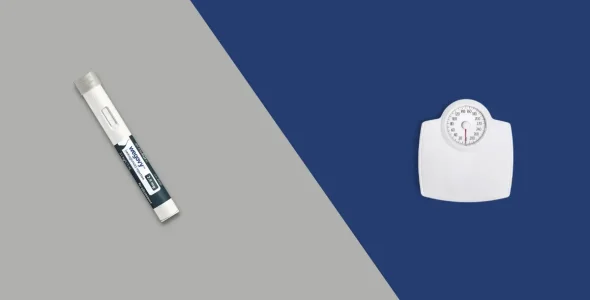Saxenda vs. Wegovy: Which weight loss drug is better?
Trying to choose between Saxenda and Wegovy for weight loss? Learn the key differences in effectiveness, convenience, and more to determine which medication is right for you.
Key highlights
- Wegovy (semaglutide) and Saxenda (liraglutide) are both injectable GLP-1 medications approved by the FDA for weight loss. Wegovy is taken once a week, while Saxenda is taken once a day.
- A recent study found that people who took Wegovy lost much more weight than those who took Saxenda.
- Wegovy is also approved to help with heart health in people who have heart disease and are overweight or obese. Saxenda is not approved for this indication.
- You can switch from Saxenda to Wegovy (or vice versa). Your doctor will help you find the right treatment and dosage for you.
Managing weight is more important than ever in health care, as many people are looking for ways to treat obesity and other weight-related problems. Two prescription medicines that have become popular for helping with weight loss are Saxenda and Wegovy.
In 2014, Saxenda (liraglutide) was the first GLP-1 medication approved for weight loss. In 2020, it was approved for use in kids aged 12 to 17. The following year, the FDA approved a similar GLP-1 drug called Wegovy (semaglutide).
These brand-name injectable drugs are part of a drug class called glucagon-like peptide-1 (GLP-1) agonists. The GLP-1 agonist market in the U.S. is rapidly growing, projected to reach over $37 billion by 2030 due to rising obesity rates and strong drug efficacy.
Saxenda (liraglutide) and Wegovy (semaglutide) are made by Novo Nordisk and work similarly, but they have different ingredients and doses. Insurance may cover one but not the other, and costs can vary.
Compare Saxenda and Wegovy for weight loss. Learn about their effectiveness, dosing, side effects, costs, and how they work in the body to help you decide which might be right for you.
Head-to-head comparison: Saxenda vs. Wegovy
Here are a few key factors to compare and contrast Saxenda and Wegovy:
Active ingredient
- Saxenda: The active ingredient in Saxenda is liraglutide, a type of GLP-1 receptor agonist. Liraglutide works by mimicking a hormone in the body that helps control blood sugar levels and appetite, leading to significant weight loss.
- Wegovy: The active ingredient in Wegovy is semaglutide, another GLP-1 receptor agonist. Like liraglutide, semaglutide also mimics a natural hormone that controls blood sugar and reduces appetite, but it has been shown to have a stronger effect on weight loss compared to liraglutide.
Dosing frequency
A key difference between Saxenda and Wegovy is how often they need to be injected.
- Saxenda: Requires a daily injection. This means you need to inject yourself once every day, which can be inconvenient for some people, especially those with busy lifestyles. The daily routine may be more challenging to stick to, and forgetting an injection could impact the effectiveness of the treatment.
- Wegovy: Requires a weekly injection. With just one injection per week, Wegovy offers greater convenience. For people with a hectic schedule, this is a significant benefit because it’s easier to remember and incorporate into weekly routines. Fewer injections also may improve adherence to the medication, as it’s less disruptive to daily life.
For many, the weekly injection of Wegovy makes it a more appealing and user-friendly option, leading to better adherence and potentially more consistent weight loss results.
Dosage titration
Saxenda and Wegovy both require a gradual increase in dosage (called titration) to help the body adjust and to reduce side effects, especially gastrointestinal ones like nausea and vomiting. However, they follow different titration schedules and reach their full, or maintenance, dose at different times.
Saxenda:
- Titration schedule: Increases by 0.6 mg each week
- Starting dose: 0.6 mg daily
- Maintenance dose: 3.0 mg daily
- Time to reach full dose: Typically reached by week 5 if tolerated by the patient
Wegovy:
- Titration schedule: Increases approximately every 4 weeks
- Starting dose: 0.25 mg once weekly
- Maintenance dose: 2.4 mg once weekly
- Time to reach full dose: Usually takes about 5 months (20 weeks)
Efficacy and weight loss results
Clinical trials have shown that Wegovy (semaglutide) leads to significantly greater weight loss than Saxenda (liraglutide), while both medications are used alongside a reduced-calorie diet and increased physical activity.
The STEP 8 trial, a 68-week randomized, head-to-head study, directly compared the effectiveness of Wegovy and Saxenda in over 300 adults with overweight or obesity (without diabetes). Results show that a significantly higher percentage of Wegovy users reached major weight loss milestones compared to Saxenda users.
FDA-approved uses
Wegovy is FDA-approved for:
- Chronic weight management in adults and adolescents (12 years and older) with obesity, or overweight with at least one weight-related health condition such as high blood pressure, type 2 diabetes, or high cholesterol.
- Reducing the risk of major cardiovascular events (MACE), such as heart attack, stroke, or cardiovascular death, in adults with obesity or overweight who also have established cardiovascular disease. In 2024, the FDA approved Wegovy to help reduce the risk of heart problems in adults with obesity or overweight and existing heart disease.
Saxenda is FDA-approved for:
- Chronic weight management in adults and adolescents (12 years and older) with obesity, or overweight with at least one weight-related condition such as high blood pressure, type 2 diabetes, or high cholesterol.
Wegovy offers proven heart health benefits in addition to weight loss, while Saxenda is approved solely for weight management. This makes Wegovy a more comprehensive option for patients with both obesity and cardiovascular disease.
Availability and shortages
As of May 2025, both Wegovy (semaglutide) and Saxenda (liraglutide) are generally available in the U.S., with recent developments affecting their supply and accessibility.
The FDA has officially declared that the shortage of Wegovy has been resolved.
Saxenda vs. Wegovy: Key similarities
Here’s a breakdown of the main ways Saxenda and Wegovy are similar, despite some key differences:
- Mechanism of action: Both Saxenda and Wegovy are GLP-1 receptor agonists; they both mimic a natural hormone (glucagon-like peptide-1) that helps to control appetite. They work by reducing hunger, slowing digestion, and increasing feelings of fullness, which helps people eat less and lose weight.
- Administration: Both medications are subcutaneous injections (injected under the skin) using pre-filled pens. Injection sites are the same for both: abdomen, thigh, or upper arm. You don’t need to inject near mealtimes, and it’s recommended to rotate sites to avoid skin irritation.
- Target patient population: Both are approved for adults and children age 12 and older with obesity (body mass index {BMI}≥ 30 kg/m²), or overweight (BMI ≥ 27 kg/m²) with at least one weight-related condition such as high blood pressure, type 2 diabetes, and high cholesterol.
- Importance of lifestyle changes: Both Saxenda and Wegovy are designed to be used along with a reduced-calorie diet and regular physical activity. They are not standalone solutions. Combining medication with lifestyle changes leads to better and more sustainable weight loss.
- Common side effects: Both drugs share similar gastrointestinal (GI) side effects, especially during the first weeks or when the dose increases, such as nausea, vomiting, diarrhea, and constipation. These side effects are often temporary and tend to improve as the body adjusts to the medication.
Saxenda vs. Wegovy: Key differences
One of the main differences between Saxenda and Wegovy is their active ingredients. Saxenda has liraglutide, and Wegovy has semaglutide. Both work as GLP-1 receptor agonists. However, Wegovy is newer, approved in 2017, while Saxenda was approved in 2010.
Dosage frequency
- Another big difference is how often you take them. Saxenda is injected once a day, while Wegovy is taken once a week. This is because Wegovy stays in the body longer than Saxenda.
- You should inject your Wegovy dose on the same day each week, at any time of day. With Saxenda, you can also inject it at any time of day. However, it might help to choose a specific time each day and stick to it, especially for daily injections.
- With both Wegovy and Saxenda, you don’t need to take your dose with meals. You can inject them in three places: the upper arm, thigh, or abdomen. It is best to change the injection site each time to avoid lumps under the skin.
Effectiveness
- Although Wegovy and Saxenda work the same way in the body, Wegovy may be more effective for weight loss when used with a low-calorie diet and regular exercise.
- A 68-week study with over 300 adults showed that people taking Wegovy lost much more weight than those taking Saxenda. Participants taking Wegovy lost an average of 16% of their body weight, while those taking Saxenda lost about 6%.
- Before this study, other research showed similar results. The largest Wegovy trial, with nearly 2,000 people, found an average weight loss of almost 15%. A Saxenda trial with over 3,700 people reported about 8% average weight loss.
Side effects
- Gastrointestinal (GI) side effects were more common with Wegovy. However, more people stopped taking Saxenda, with half of them stopping because of side effects. Saxenda also had higher rates of gallstones and insomnia.
- Despite their differences, Wegovy and Saxenda share many of the same side effects. Common ones include nausea, diarrhea, and stomach upset, especially when starting the treatment or increasing the dose. However, these side effects often get better over time for most people.
FDA-approved uses
- Saxenda and Wegovy are FDA-approved for chronic weight management in adults with a BMI of 30 or more (obese) or 27 or more (overweight) with at least one weight-related health condition, such as type 2 diabetes, high blood pressure, or high cholesterol. Both medications are also approved to treat obesity in children ages 12 and older.
- Saxenda can be used by kids 12 and older who weigh over 132 pounds and are considered obese based on adult BMI. Wegovy is also approved for kids 12 and up, but only for those in the top 5% for weight and height, meaning they may have more serious obesity.
- Both drugs should be used with a healthy, low-calorie diet and regular exercise.
Heart problems
- Unlike Saxenda, Wegovy is approved to help people with heart disease who are overweight or obese by lowering the risk of serious heart problems, like heart attacks, strokes, or cardiovascular death. These are called major adverse cardiovascular events (MACE).
- In a 5-year clinical trial, Wegovy was found to lower the risk of major heart problems (MACE) by 20% compared to a placebo (an injection with no medication). It also led to fewer heart attacks, strokes, and cardiovascular deaths.
Saxenda vs. Wegovy: Key differences
| Saxenda | Wegovy | |
|---|---|---|
| Drug class | GLP-1 receptor agonist | GLP-1 receptor agonist |
| Active ingredient | Liraglutide | Semaglutide |
| Form | Subcutaneous injection | Subcutaneous injection |
| Frequency | Daily injection | Weekly injection |
| Standard dosage | 0.6 mg injected under the skin once daily for 1 week. Then, the dosage is gradually increased in weekly intervals to a target dosage of 3 mg once daily. | 0.25 mg injected under the skin once weekly for 4 weeks. Then, the dosage is gradually increased to 1.7 or 2.4 mg once weekly. |
| Avg. weight loss | 8% of body weight over 68-weeks | 15% of body weight over 68-weeks |
| Typical duration of treatment | Long-term | Long-term |
| Approved for population | Adults and children ages 12 and older | Adults and children ages 12 and older |
Effectiveness for weight loss: Which works better?
Wegovy and Saxenda are injection pens proven to help with weight loss. They work by boosting insulin and reducing appetite, which helps people lose weight. However, some studies show that Wegovy might help you more with weight loss than Saxenda.
In a 68-week study, adults with obesity or overweight lost significantly more weight with Wegovy (semaglutide) taken once a week than with Saxenda (liraglutide) taken daily. Both were used with a low-calorie diet and increased physical activity, but more people using semaglutide lost 20% or more of their initial body weight, about one-third of them, compared to only 6% of those using liraglutide.
Another study showed that Wegovy might be more effective for weight loss and better value than Saxenda. While both drugs help with weight loss, semaglutide (Wegovy) resulted in more weight loss on average and was cheaper per percentage of weight loss compared to liraglutide (Saxenda).
Talk to a healthcare provider and find the best medication for your needs. The weight loss results from either medication can vary based on your medical history or how your body responds to the medicine.
Dosage and administration: Which is easier to use?
- Saxenda: Daily subcutaneous injection. The dose is gradually increased over several weeks to minimize side effects. Daily injections may be challenging for individuals with busy schedules or those who prefer less frequent dosing.
- Wegovy: Weekly subcutaneous injection. Similar to Saxenda, the dose is gradually increased the dose over several weeks. Weekly dosing can be more convenient for individuals who prefer fewer injections.
Studies have shown that patients often prefer medications with less frequent dosing schedules. For instance, a study comparing dulaglutide and semaglutide found that 84.2% of participants preferred the dulaglutide device, which is administered weekly, over the semaglutide device, which is also weekly but perceived differently by patients. This preference highlights the importance of dosing frequency in medication adherence.
Side effects and safety: Which is more tolerable?
While Saxenda and Wegovy work in similar ways and share many side effects, clinical studies suggest that Wegovy may be better tolerated overall, even though it can cause more gastrointestinal issues early on.
Boxed warning
Both Saxenda (liraglutide) and Wegovy (semaglutide) carry an FDA-boxed warning due to the risk of thyroid C-cell tumors observed in animal studies.
In rodent studies, GLP-1 receptor agonists like Saxenda and Wegovy caused thyroid C-cell tumors, including medullary thyroid carcinoma (MTC).
It’s not known whether these findings apply to humans, but the potential risk cannot be ruled out.
Do NOT use Saxenda or Wegovy if:
- You have a personal or family history of MTC, a rare type of thyroid cancer.
- You have been diagnosed with Multiple Endocrine Neoplasia syndrome type 2 (MEN 2), a genetic condition linked to endocrine tumors.
Potential side effects
Saxenda and Wegovy may cause similar side effects, like stomach issues, such as nausea, constipation (more common with Wegovy), vomiting, diarrhea, indigestion, and stomach pain. They may also cause dizziness and headaches.
Both medications can cause reactions at the injection site, like swelling, itching, or redness, but Saxenda may cause these more often than Wegovy. As well, Saxenda can raise lipase enzyme levels, and Wegovy may cause symptoms like a sore throat and runny nose.
Severe risks
Serious side effects of Saxenda and Wegovy can include severe allergic reactions, like hives, trouble breathing, or swelling in the face, lips, or throat. Some other serious risks include pancreas inflammation, low blood sugar (hypoglycemia), gallbladder issues, and kidney problems.
While both medications are generally well tolerated, they come with some distinct, serious risks that patients and healthcare providers should be aware of:
- Higher risk of hypoglycemia in diabetics, especially in people with type 2 diabetes who are also taking insulin or other glucose-lowering medications.
- Wegovy has been associated with a higher rate of gallbladder-related issues, such as gallstones or cholecystitis (gallbladder inflammation).
Contraindications and precautions
Both Saxenda and Wegovy have similar warnings. They come with a box warning about the possible risk of thyroid tumors. People with a personal or family history of medullary thyroid cancer (MTC) or multiple endocrine neoplasia type 2 (MEN 2) should avoid these medications.
Saxenda and Wegovy can increase heart rate, which can cause problems for individuals with heart disease or high blood pressure. They also carry risks like pancreatitis, gallbladder issues, kidney problems, and suicidal thoughts or behaviors. Low blood sugar (hypoglycemia) is another risk, especially for people taking other diabetes medications.
Get medical help right away if your side effects last or get worse. You should seek emergency care if you have signs of an allergic reaction, like hives, swelling in your face or throat, or trouble breathing.
Tolerability
Clinical trials have shown that while both Wegovy (semaglutide) and Saxenda (liraglutide) can cause gastrointestinal (GI) side effects such as nausea, vomiting, diarrhea, and constipation, Wegovy is generally better tolerated over time.
In the STEP 8 trial, which directly compared the two medications over 68 weeks, a significantly lower percentage of participants stopped taking Wegovy due to side effects compared to those on Saxenda. Approximately 13.5% of participants in the Wegovy group discontinued treatment, whereas 27.6% of those in the Saxenda group did so, with nearly half of the Saxenda discontinuations attributed to adverse effects.
These findings suggest that although initial side effects with Wegovy may be more noticeable, patients are more likely to continue treatment, making it a more tolerable option in the long term.
Cost and insurance coverage
Both Saxenda (liraglutide) and Wegovy (semaglutide) are GLP-1 receptor agonists approved for weight loss, but they differ in cost and insurance coverage.
Out-of-pocket costs
- Saxenda: The list price for a 30-day supply is approximately $1,349.02. Without insurance, the average monthly cost is around $1,300.
- Wegovy: The list price for a 30-day supply is approximately $1,349.02. Without insurance, the average monthly cost is around $1,300.
Saxenda vs. Wegovy: Cost comparison
| Saxenda | Wegovy | |
|---|---|---|
| List price | $1,349.02 | $1,349.02 |
| Avg. retail price | $1,200 - $ 1,400 | $1,200 - $ 1,400 |
| Insurance coverage | Usually not covered (weight loss) | Usually not covered (weight loss) |
| Medicare Part D coverage | No | No |
| Quantity | 5 prefilled injection pens | 4 prefilled injection pens |
Insurance coverage
Insurance coverage for these weight loss drugs can differ depending on the plan, but most insurance plans don’t cover weight-loss treatments. Some plans may cover Saxenda or Wegovy, while others may not, so many patients might have to pay the full price. A month’s supply of Saxenda and Wegovy costs about $1,300 without insurance.
The coverage for both drugs varies by insurance plan. Some plans may cover them, but it is not typically covered by Medicare Part D for weight loss.
Who should choose Saxenda?
Saxenda may be a better choice for certain patients based on lifestyle, weight loss goals, and how their body reacts to medication.
You might choose Saxenda if you:
- Prefer daily dosing: Some people find it easier to manage a medication that’s taken daily, especially if they want more control over side effects or faster dose adjustments. Saxenda is injected once a day, which allows for more gradual titration compared to weekly shots like Wegovy.
- Have milder weight loss goals: Saxenda tends to lead to moderate weight loss, often in the range of 5–8% of body weight. This may be enough for people with less weight to lose or those aiming for smaller, sustainable changes.
- Can tolerate liraglutide better: Saxenda contains liraglutide, which some patients tolerate better than semaglutide (in Wegovy). For example, people who experience severe constipation or nausea on Wegovy may find Saxenda gentler on the digestive system.
Who should choose Wegovy?
You should consider choosing Wegovy if you:
- Are seeking maximum weight loss: Wegovy has shown the most weight loss among currently approved obesity medications, helping many people lose 12% or more of their body weight. This makes it ideal for individuals who have significant weight to lose and want strong results.
- Prefer weekly injections: Unlike Saxenda, which requires daily injections, Wegovy is given once a week, which many people find easier to stick to. Fewer injections can lead to better treatment adherence and more consistent results.
- Have insurance coverage for obesity medications: Wegovy is expensive, so it’s best suited for people who have insurance that covers it or are eligible for programs that help with the cost. Otherwise, the high price may be a barrier.
- Have cardiovascular disease: In 2024, Wegovy was approved for reducing the risk of heart attack and stroke in adults with cardiovascular disease and obesity or overweight. This makes it especially valuable for people with heart conditions, as it offers both weight loss and heart health benefits.
Alternatives if neither medication works
It’s essential to remember that any changes to your weight-loss medication, whether starting, stopping, or switching, depend on your medical condition and should only be made under the medical advice of a qualified healthcare provider
Here are some commonly used alternatives to Wegovy:
Zepbound (tirzepatide)
Zepbound is an FDA-approved weight loss drug that contains the same active ingredient as Mounjaro, tirzepatide. It is a newer medicine and more effective than both Saxenda and Wegovy.
Zepbound is FDA-approved for weight management in adults with obesity (BMI of 30 or higher) or overweight (BMI of 27 or higher) and related health issues like high blood pressure or diabetes.
Zepbound is a once-weekly injection that works by targeting two hormones (GLP-1 and GIP) to help reduce appetite and improve blood sugar control, making it a powerful option for weight loss. It’s administered as a weekly injection, similar to Mounjaro.
Mounjaro (tirzepatide)
Mounjaro is a brand-name injectable medication approved for type 2 diabetes, manufactured by Eli Lilly. Mounjaro activates GIP and GLP-1 pathways to help control blood sugar in people with type 2 diabetes and helps with weight loss.
The average retail price for a one-month supply of Mounjaro is $1,086.76 for a pack of pens.
If your commercial insurance covers Mounjaro, you can pay as little as $25 for a 1-month, 2-month, or 3-month prescription with the Mounjaro Savings Card. If you have commercial insurance without coverage for Mounjaro, the card can save you up to $463 for a 1-month prescription.
Rybelsus (semaglutide)
Rybelsus is an oral tablet that is FDA-approved for lowering blood sugar levels in adults with type 2 diabetes and may also help with weight loss. Although it’s not FDA-approved to reduce the risk of heart attack or stroke, studies show it’s safe for people with heart disease.
The common side effects of Rybelsus are nausea, vomiting, diarrhea, constipation, and abdominal pain. Although rare, some people taking Rybelsus may experience a severe allergic reaction, kidney or gall bladder problems, low blood sugar (hypoglycemia), pancreatitis (inflammation of the pancreas), diabetic retinopathy, and thyroid cancer.
Without insurance, a 30-day supply of Rybelsus costs about $997.58. If you’re eligible, you could pay $10 for Rybelsus (1-month supply) with a copay savings card from the manufacturer. The Rybelsus Savings Card program is limited to those with commercial insurance.
How to save on Saxenda and Wegovy
Here are some strategies that can be used to save on Saxenda and Wegovy:
Saxenda Savings Card program
Novo Nordisk, the manufacturer of Saxenda, offers a Saxenda savings card program, which is eligible for commercially insured patients who may pay as little as $25 per 30-day prescription.
This card can be used at participating pharmacies. It is not valid for patients on Medicare, Medicaid, or other federal/state healthcare programs.
Pharmacy discount cards
Free discount programs like GoodRx, SingleCare, and WellRx may help lower out-of-pocket costs if you’re paying cash.
Prices can vary, so it’s worth comparing across all prescription drug discount websites and local pharmacies.
Generic liraglutide
The FDA approved generic liraglutide (Victoza), the first generic of a once-daily GLP-1 injection, in December 2024.
Wegovy Savings Card program
With the Wegovy Saving Card, you could pay as little as $0 per month if your commercial insurance covers Wegovy, with a maximum savings of $225 per month.
To qualify for the Wegovy Savings Card, you must meet certain criteria. If you’re eligible for the savings card, you can join WeGoTogether for free. This program offers personalized support to help with weight loss and maintenance, including access to a health coach, a progress-tracking portal, and more.
If you have commercial insurance that doesn’t cover Wegovy or are paying with cash (excluding government beneficiaries), you’ll pay $499 for a 28-day supply of Wegovy. This offer is available for all 5 dose strengths of Wegovy.
NovoCare Pharmacy
NovoCare Pharmacy is an option for patients who do not have insurance coverage for Wegovy. You can purchase all dosage strengths of the medication for $499 per month, directly from the manufacturer’s direct-to-consumer pharmacy.
Frequently asked questions
Can I switch from Saxenda to Wegovy?
Yes, you can switch from Saxenda to Wegovy, but it should be done with your doctor’s guidance. They will help adjust the dose and ensure the change is safe for you.
Which has more nausea, Saxenda or Wegovy?
Saxenda may cause more nausea at the beginning of treatment. Wegovy can cause nausea, too, but it’s more common over the long term.
Is Wegovy worth the extra cost?
For most people, Wegovy is worth the extra cost because it often helps with more weight loss than Saxenda. Many find that the better results make it a good investment in their health.
Does Medicare cover Saxenda or Wegovy?
Medicare generally does not cover Saxenda or Wegovy for weight loss due to a federal law from 2003. However, in March 2024, the FDA approved Wegovy for reducing the risk of heart attack and stroke in adults with cardiovascular disease and obesity or overweight. As a result, Medicare Part D plans may now cover Wegovy for this specific use.
Conclusion
Wegovy (semaglutide) and Saxenda (liraglutide) are GLP-1 prescription medications with different active ingredients that can help with weight loss when used with a healthy diet and exercise.
Both are FDA-approved self-injectable medications with similar side effects. However, Wegovy also has proven heart health benefits.
Wegovy is given only once weekly compared to Saxenda, which is given once daily. However, in clinical trials, people using Wegovy lost about twice as much weight as those using Saxenda.
Always consult a healthcare professional to make the best decision based on your specific health needs and circumstances. They can help guide you in choosing the right medication and treatment plan in your weight loss journey.









